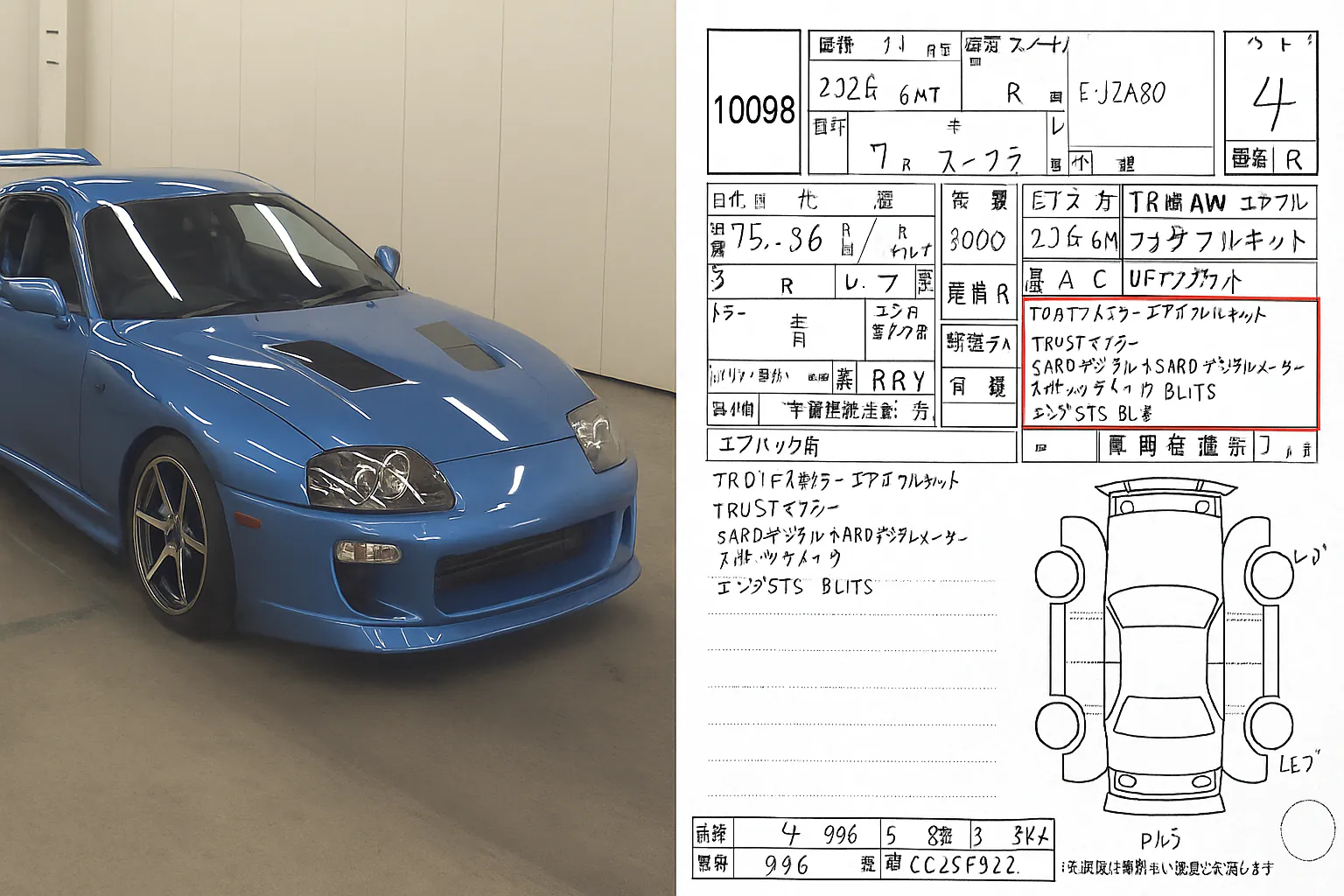
For anyone buying a car from a Japanese auction, the auction sheet is the single most important document you will encounter. It provides an independent evaluation of the vehicle’s condition, covering everything from accident history to interior wear. However, for many first-time buyers, the sheet can seem overwhelming—written in Japanese, filled with abbreviations, numbers, and diagrams.
In this guide, we’ll explain how to read a Japanese auction sheet, what the grade ratings mean, and how you can use this information to make a confident purchase.
Why Auction Sheets Matter
Unlike local used car markets where condition can be vague or misrepresented, Japanese auctions pride themselves on transparency. Each car is inspected by professional evaluators before the auction, and their findings are recorded on the auction sheet.
This system protects buyers by providing:
-
Verified mileage.
-
Honest notes on cosmetic and mechanical condition.
-
Clear identification of repairs or accident history.
-
A grading system to quickly assess overall quality.
When understood properly, the auction sheet becomes your best tool to judge whether a car is worth bidding on.
Main Sections of the Auction Sheet
While layouts differ slightly across auction houses, most sheets contain the following sections:
1. Vehicle Information
At the top, you’ll find basic details such as:
-
Make and model
-
Year of manufacture
-
Chassis number
-
Engine type and size
-
Transmission (AT/MT)
-
Mileage (in kilometers)
This section verifies that the car matches your search criteria.
2. Auction Grade
The overall grade is the first thing most buyers look at. It represents a summary of the car’s condition, factoring in mileage, exterior, interior, and accident history. More on grades below.
3. Interior and Exterior Grades
Separate letter grades are often assigned for the interior and exterior:
-
A: Excellent condition.
-
B: Good condition with minor wear.
-
C: Average condition with visible wear.
-
D: Below average, may need reconditioning.
4. Inspector’s Notes
This section contains written remarks from the auction inspector. Typical comments include:
-
“Repainted panels”
-
“Small scratches”
-
“Engine noise”
-
“Cigarette smell in interior”
Since these notes are in Japanese, exporters like Autocom Japan provide translations and explanations.
5. Condition Diagram
One of the most useful parts of the sheet is the vehicle diagram. It shows a bird’s-eye view of the car with codes indicating dents, scratches, rust, or repairs. Common abbreviations include:
-
A: Scratch
-
U: Dent
-
W: Wave or panel distortion
-
Y: Rust
-
X: Panel needs replacement
-
XX: Panel has been replaced
Numbers (1–4) indicate severity, with 1 being light and 4 being heavy. For example, “A1” is a small scratch, while “U3” means a large dent.
Understanding Auction Grades
Here’s what the overall grades mean across most major auction houses:
-
Grade 6 / 5: Nearly new. Extremely rare, often less than 10,000 km.
-
Grade 4.5: Excellent condition, minimal wear, low mileage. Very desirable.
-
Grade 4: Good condition, average wear, typically under 100,000 km. Popular choice for export.
-
Grade 3.5: Average used car condition. May have higher mileage or cosmetic issues.
-
Grade 3: Noticeable wear, scratches, dents, or higher mileage. Still usable but may need work.
-
Grade 2: Poor condition. May have rust, heavy wear, or major issues.
-
Grade 1: Usually indicates modified or heavily repaired vehicles.
-
Grade R/RA: Accident-repaired cars. Quality of repairs varies from minor to significant.
-
Grade 0: For vehicles that don’t fit standard grading, such as flood or fire damage.
Why Mileage Matters Alongside Grade
A high grade doesn’t always mean low mileage. For example, a car with 120,000 km but well-maintained could still earn a Grade 4. Similarly, a car with 40,000 km that has been in an accident may receive a Grade RA.
This is why you should always consider both grade and mileage together when assessing quality.
Common Misinterpretations
Many first-time buyers misunderstand the grading system:
-
Thinking Grade 3.5 is “bad.” In reality, it often represents a normal used car with some cosmetic wear.
-
Overlooking R-grade vehicles. Some repaired cars are perfectly safe and driveable, but resale value may be lower.
-
Assuming interior grade “C” means dirty. It might just mean minor wear on seats or panels.
Exporters can help explain what each grade means for your specific needs.
How Autocom Japan Helps Buyers
Reading and interpreting auction sheets takes experience. Autocom Japan assists clients by:
-
Translating auction sheets into English.
-
Explaining grading differences across auction houses.
-
Advising whether a grade is suitable for your market.
-
Recommending cars that balance price, quality, and resale value.
By relying on experts, buyers avoid costly mistakes and gain confidence in their purchase.
Final Thought
Japanese auction sheets are incredibly detailed and trustworthy, but they require careful interpretation. By understanding the main sections, the grading system, and the condition codes, buyers can make informed decisions about which cars are worth bidding on.
Ultimately, the auction sheet is not just paperwork—it is your window into the true condition of the car. With the right guidance from an experienced exporter like Autocom Japan, you can navigate these documents with ease and secure vehicles that meet your expectations in both quality and value.

